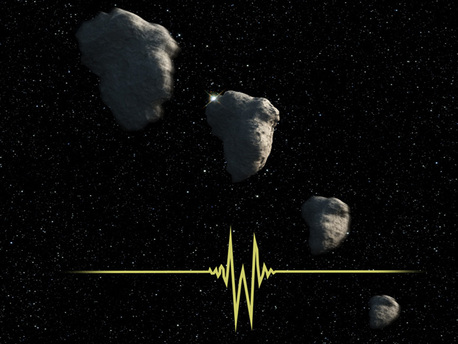Kuiper Belt
Hubble Finds Needle In A Haystack
 © NASA, ESA, and G. Bacon (STScI) |
This is an artist's impression of a small Kuiper Belt Object (KBO) occulting a star. NASA's Hubble Space Telescope recorded this brief event and allowed astronomers to determine that the KBO was only one-half of a mile across, setting a new record for the smallest object ever seen in the Kuiper Belt.
This is the first observational evidence for a population of comet-sized bodies in the Kuiper Belt that are being ground down through collisions. The Kuiper Belt is therefore collisionally evolving, meaning that the region's icy content has been modified over the past 4.5 billion years.
The object detected by Hubble is so faint — at 35th magnitude — it is 100 times dimmer than what Hubble can see directly.
So then how did the space telescope uncover such a small body?
Hilke Schlichting and her collaborators are reporting that the telltale signature of the small vagabond was extracted from Hubble's pointing data, not by direct imaging. Hubble has three optical instruments called Fine Guidance Sensors (FGS). The FGSs provide high-precision navigational information to the space observatory's attitude control systems by looking at select guide stars for pointing. The sensors exploit the wavelike nature of light to make precise measurement of the location of stars.
Schlichting and her co-investigators determined that the FGS instruments are so good that they can see the effects of a small object passing in front of a star. They selected 4.5 years of FGS observations for analysis. Hubble spent a total of 12,000 hours during this period looking along a strip of sky within 20 degrees of the solar system's ecliptic plane, where the majority of KBOs should dwell. The team analyzed the FGS observations of 50,000 guide stars in total.
Scouring the huge database, Schlichting and her team found a single 0.3-second-long occultation event. This was only possible because the FGS instruments sample changes in starlight 40 times a second. The duration of the occultation was short largely because of the Earth's orbital motion around the Sun.
Hubble observations of nearby stars show that a number of them have Kuiper Belt–like disks of icy debris encircling them. These disks are the remnants of planetary formation. The prediction is that over billions of years the debris should collide, grinding the KBO-type objects down to ever smaller pieces that were not part of the original Kuiper Belt population.
The finding is a powerful illustration of the capability of archived Hubble data to produce important new discoveries. In an effort to uncover additional small KBOs, the team plans to analyze the remaining FGS data for nearly the full duration of Hubble operations since its launch in 1990.
Source: Hubble/NASA
Kuiper Belt
Hubble Finds Needle In A Haystack
 © NASA, ESA, and G. Bacon (STScI) |
This is an artist's impression of a small Kuiper Belt Object (KBO) occulting a star. NASA's Hubble Space Telescope recorded this brief event and allowed astronomers to determine that the KBO was only one-half of a mile across, setting a new record for the smallest object ever seen in the Kuiper Belt.
This is the first observational evidence for a population of comet-sized bodies in the Kuiper Belt that are being ground down through collisions. The Kuiper Belt is therefore collisionally evolving, meaning that the region's icy content has been modified over the past 4.5 billion years.
The object detected by Hubble is so faint — at 35th magnitude — it is 100 times dimmer than what Hubble can see directly.
So then how did the space telescope uncover such a small body?
Hilke Schlichting and her collaborators are reporting that the telltale signature of the small vagabond was extracted from Hubble's pointing data, not by direct imaging. Hubble has three optical instruments called Fine Guidance Sensors (FGS). The FGSs provide high-precision navigational information to the space observatory's attitude control systems by looking at select guide stars for pointing. The sensors exploit the wavelike nature of light to make precise measurement of the location of stars.
Schlichting and her co-investigators determined that the FGS instruments are so good that they can see the effects of a small object passing in front of a star. They selected 4.5 years of FGS observations for analysis. Hubble spent a total of 12,000 hours during this period looking along a strip of sky within 20 degrees of the solar system's ecliptic plane, where the majority of KBOs should dwell. The team analyzed the FGS observations of 50,000 guide stars in total.
Scouring the huge database, Schlichting and her team found a single 0.3-second-long occultation event. This was only possible because the FGS instruments sample changes in starlight 40 times a second. The duration of the occultation was short largely because of the Earth's orbital motion around the Sun.
Hubble observations of nearby stars show that a number of them have Kuiper Belt–like disks of icy debris encircling them. These disks are the remnants of planetary formation. The prediction is that over billions of years the debris should collide, grinding the KBO-type objects down to ever smaller pieces that were not part of the original Kuiper Belt population.
The finding is a powerful illustration of the capability of archived Hubble data to produce important new discoveries. In an effort to uncover additional small KBOs, the team plans to analyze the remaining FGS data for nearly the full duration of Hubble operations since its launch in 1990.
Source: Hubble/NASA





